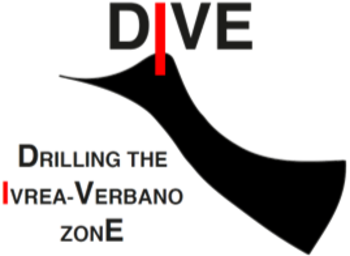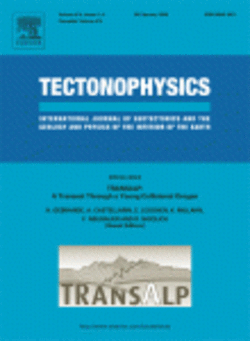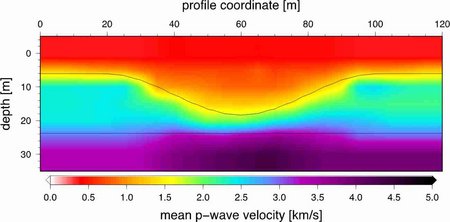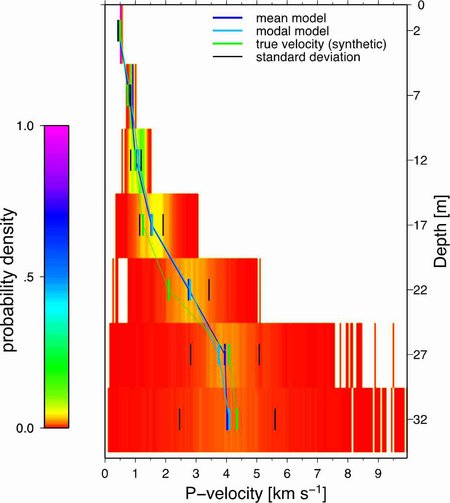DIVE - Drilling the Ivrea-Verbano zonE
Together with colleagues from the universities of Lausanne (CH), Georgia (USA), Trieste (IT), and the Italian National Research Council, geophysicists from Montanuniversität Leoben are preparing to drill a bore-hole through the boundary of the Earth’s crust and the mantle, also known as the “Moho”, to learn more about the nature of this transition.
It has been the dream of geoscientists since its discovery in 1910 by seismologist Andrija Mohorovicic, who studied seismic waves, excited by an earthquake near Zagreb. Since the continental Moho has an average depth of about 30 km, no drilling equipment could withstand the corresponding temperature (600°) and pressure (1 GPa) conditions. However, tectonic movements related to the Alpine orogeny led to a shallowing of this boundary to only 3-4 km depth in the Ivrea-zone between the Matterhorn and Lake Maggiore. The Drilling the Ivrea-Verbano zonE (DIVE) project has been accept-ed by the International Continental Scientific Drilling Program (ICDP), which Austria has been a member of since 2001.
To prepare the drilling, seismic surveys were conducted in the area in 2019/2020 by MUL in cooperation with the University of Lausanne and GFZ Potsdam (DE). These data are currently undergoing advanced image processing to provide detailed site characterization


SLIM - sustainable low impact mining
Quarries, and occasionally open pit mines, are increasingly being established near to communities and existing blasting sites are being encroached by expanding communities. Thus the unavoidable side effects of rock blasting, such as ground vibrations, air blast, fly-rock, are an issue of increasing importance. In Europe, ground vibrations from blasting are subject to legal restrictions and norms. The operation permit of a blasting site demands that those limits are not exceeded.
Current mitigation strategies include: decreasing the size of the charges that detonate using smaller drill-holes, using decked charge or fewer blast-holes in a round. Such actions are most probably associated with higher costs an poorer productivity. One could also change the initiation direction and delay times in the round while avoiding the other cost driving actions. Most work of the latter type is based either on trial-and-error, or on very simplified models that don't take the actual site specific factors into account, such as the viscoelastic subsurface properties and the topography.
SLIM's breakthrough consists of using state-of-the-art seismic techniques of waveform modeling that includes a realistic subsurface description in combination with electronic delay detonators to minimize blast vibrations at selected sensitive targets.
This will provide a systematic way of adapting the geometry and initiation pattern of a blasting round so that the vibration amplitudes at critical frequencies at sensitive targets are minimized. This will allow the blasting site to reach a more economic compromise with legitimate environmental claims, e.g. by operating closer to sensitive targets and thereby allowing mining of otherwise uneconomic parts of deposits.
This project has received funding from the European Union’s Horizon 2020 research and innovation programme 2014-2018 under grant agreement No 730294.


Final Volume 2006: TRANSALP - A Transect Through a Young Collisional Orogen (Tectonophysics, Special Issue, Vol.414, Iss.1-4, p.1-282)

Contents
Editorial
TRANSALP - A transect through a young collisional orogen: Introduction
H. Gebrande, A. Castellarin, E. Lüschen, K. Millahn, F. Neubauer and R. Nicolich (p.1)
Research Papers
TRANSALP - deep crustal Vibroseis and explosive seismic profiling in the Eastern Alps
E. Lüschen, D. Borrini, H. Gebrande, B. Lammerer, K. Millahn, F. Neubauer, R. Nicolich and TRANSALP Working Group (p.9)
TRANSALP - Cross-line recording during the seismic reflection transect in the Eastern Alps
K. Millahn, E. Lüschen, H. Gebrande and TRANSALP Working Group (p.39)
Crustal structure of the Eastern Alps along the TRANSALP profile from wide-angle seismic tomography
F. Bleibinhaus and H. Gebrande (p.51)
Wide-angle observations of ALP 2002 shots on the TRANSALP profile: Linking the two DSS projects
F. Bleibinhaus, E. Brückl and ALP 2002 Working Group (p.71)
Reviewing pre-TRANSALP DSS models
R. Cassinis (p.79)
Shallow high-resolution seismics and reprocessing of industry profiles in southern Bavaria: The Molasse and the northern Alpine front
R. Thomas, K. Schwerd, K. Bram and J. Fertig (p.87)
Experimental and texture-derived P-wave anisotropy of principal rocks from the TRANSALP traverse: An aid for the interpretation of seismic field data
K. Ullemeyer, S. Siegesmund, P.N.J. Rasolofosaon and J.H. Behrmann (p.97)
Shear wave splitting in the Eastern Alps observed at the TRANSALP network
J. Kummerow, R. Kind and TRANSALP Working Group (p.117)
New gravity maps of the Eastern Alps and significance for the crustal structures
C. Zanolla, C. Braitenberg, J. Ebbing, M. Bernabini, K. Bram, G. Gabriel, H.-J. Götze, S. Giammetti, B. Meurers, R. Nicolich and F. Palmieri (p.127)
The lithospheric density structure of the Eastern Alps
J. Ebbing, C. Braitenberg and H.-J. Götze (p.145)
A review of the thermal regime of the Eastern Alps with respect to the effects of paleoclimate and exhumation
H.-D. Vosteen, V. Rath, C. Clauser and B. Lammerer (p.157)
Paleomagnetic evidence for large en-bloc rotations in the Eastern Alps during Neogene orogeny
W. Thöny, H. Ortner and R. Scholger (p.169)
From Middle Jurassic heating to Neogene cooling: The thermochronological evolution of the southern Alps
M. Zattin, A. Cuman, R. Fantoni, S. Martin, P. Scotti and C. Stefani (p.191)
The Alpine evolution of the Southern Alps around the Giudicarie faults: A Late Cretaceous to Early Eocene transfer zone
A. Castellarin, G.B. Vai and L. Cantelli (p.203)
Structural synthesis of the Northern Calcareous Alps, TRANSALP segment
J.H. Behrmann and D.C. Tanner (p.225)
Kinematics of the Inntal shear zone-sub-Tauern ramp fault system and the interpretation of the TRANSALP seismic section, Eastern Alps, Austria
H. Ortner, F. Reiter and R. Brandner (p.241)
Structure of the lithosphere beneath the Eastern Alps (southern sector of the TRANSALP transect)
A. Castellarin, R. Nicolich, R. Fantoni, L. Cantelli, M. Sella and L. Selli (p.259)
Elastic full seismic waveform inversion of safod data
This project aims at a seismic site characterization of the San-Andreas-Fault-Observatory-at-Depth (SAFOD) from controlled-source refraction- and reflection-seismic data using elastic Full Waveform Inversion (FWI). Previous studies based on acoustic FWI, travel-time tomography, and reflection Imaging provide detailed models down to 5 km depth but fail to resolve relevant details of the fault zone structure. Within this project we invert the seismic wave equation in 2D to obtain high-resolved P- and S-wave models. The project is funded by DFG within the ICDP special program.
Duration: 10/2014 - 9/2017
Personnel: J. Zeiß, MSc
Probabilisitic estimation of uncertainties for 2D and 3d refraction sesmic tomographic models
The goal of this project is to improve the efficiency of fully non-linear Markov chain Monte Carlo methods to obtain quantitative estimates of uncertainty for the inverted model parameters. We investigate the potential of multi-variate perturbations obtained propagating a random perturbation through the Resolution matrix. The project is funded by FWF.
Duration: 9/2011 - 8/2016
Personnel: C. Tauchner, BSc


